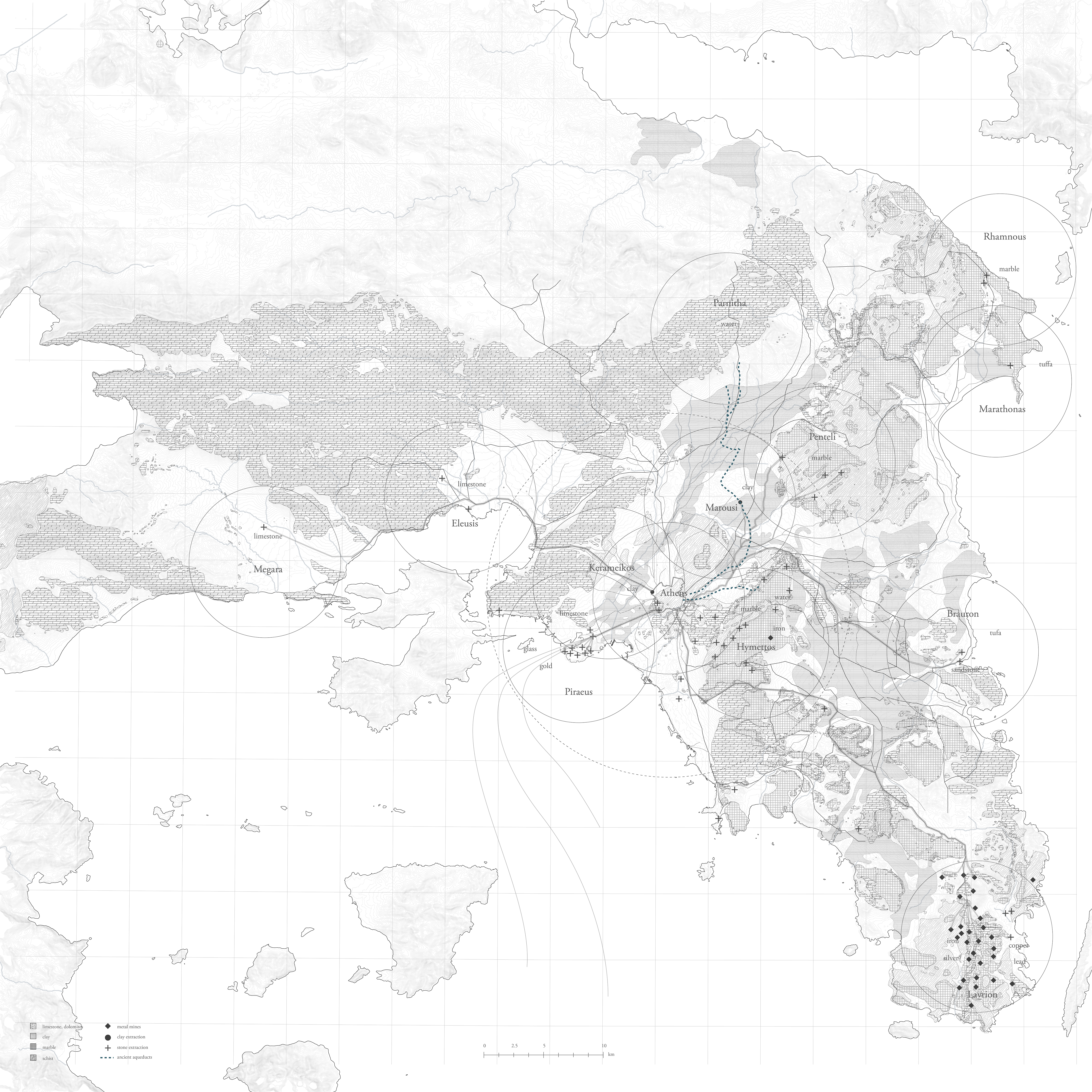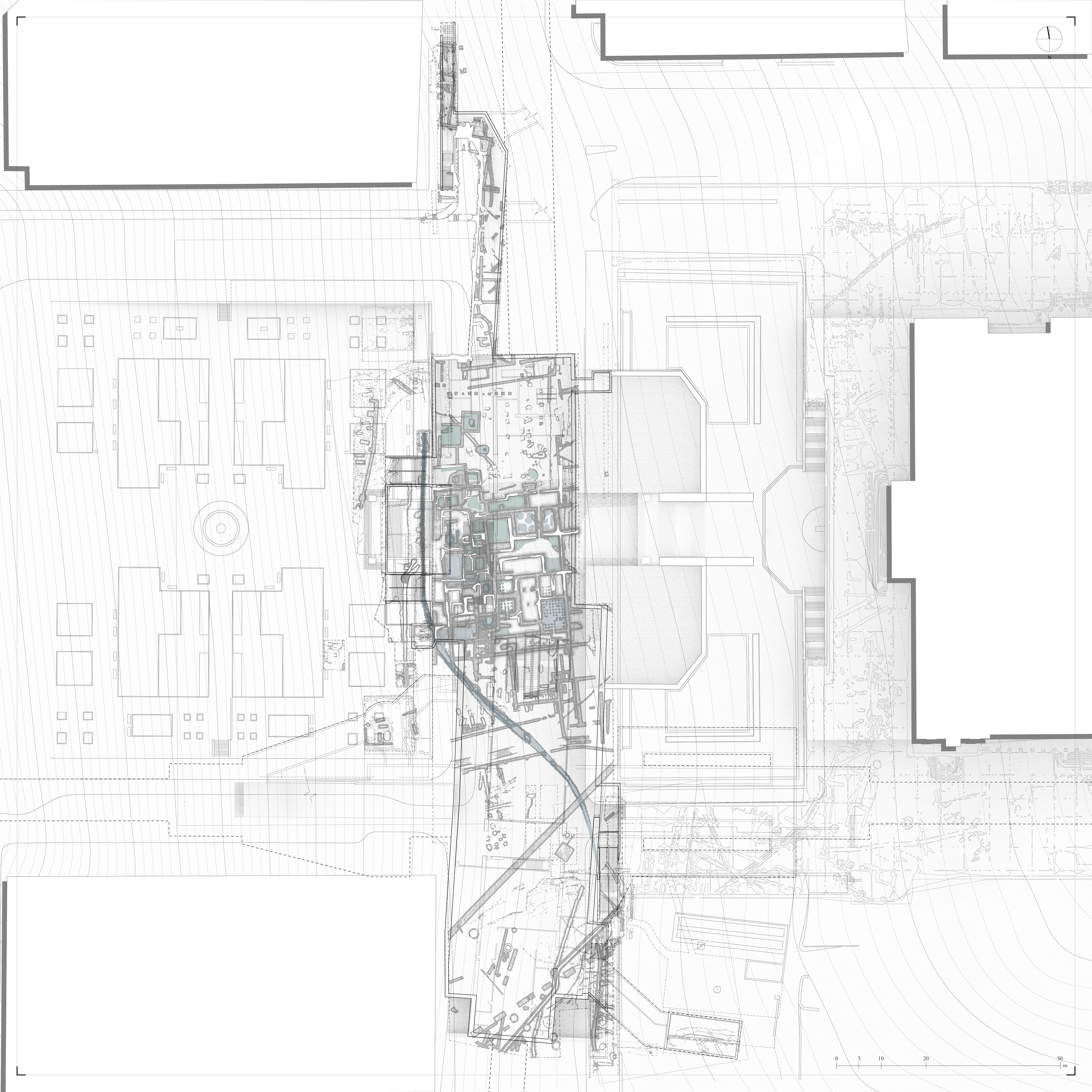NATIONAL GARDEN FOR SUBTERRANEAN HERITAGE
A REPOSITORY FOR HUMAN/EARTHLY MATTER
Fall 2021 - Spring 2022
Master of Landscape Architecture Thesis
Harvard University Graduate School of Design
Advised by Rosalea Monacella
Master of Landscape Architecture Thesis
Harvard University Graduate School of Design
Advised by Rosalea Monacella
The National Garden for Subterranean Heritage reconceptualizes the botanical National Garden of Athens, Greece, as a networked repository for human/earthly stories. Critiquing colonial practices of transplantations and classifications of imposed fragmentations embedded in the National Garden, the repository investigates situated knowledges of ground matter exposed within the subterranean metro network. National is redefined as the temporal entanglements of human inhabitations and geologic transformations, unearthed in proposed Gardens of Human/Earthly Matter within the Syntagma, Acropolis, Monastiraki, and Evangelismos stations and curated at the Repository of Subterranean Heritagewithin the existing botanical garden. Reacting to the absence of earthly agencies in Athens’s historical narratives, the repository restores Theophrastus’s didactic empirical gardens exhibiting conglomerated strata as coauthored systems of air, water, earth, fire, and live matter. Ancient fragments, infrastructures, and material flows are resurfaced in the decentralized gardens, exposing the agencies of power, culture, economy, and life in the formation of the city.






Curatorial plan of the proposed Repository of Subterranean Heritage, transforming the existing National Garden in Athens, Greece.

Territorial map of the decentralized National Garden for Subterranean Heritage, including the four gardens of Power, Economy, Culture, and Life and the Repository of Subterranean Heritage.

Map of Attica illustrating the ancient extraction of matter from geologic layers and the material flows that constructed the ancient city of Athens.

Detailed map of the Attica region, illustrating the geologic conditions from which material was sourced in ancient times for the construction of the ancient city-now subterranean geocultural conditions within the historic center of Athens.

Timelines of evolution of ground matter for the sites of the Gardens and the Repository, correlating the generalized “human history” lineage of Athens to the evolution of materiality for each site. The drawing begins from the pure bedrock condition (bottom) with the first human inhabitation of the landscape to the contemporary layer of the city (top) in 2022.
GARDENS OF POWER
Departing from Syntagma (Σύνταγμα) Station, the artefacts of human/earthly infrastructures are examined here in their relationship to power dynamics and from the elemental methodology of matter indexes. Archaeologic excavations as part of the construction of the metro station at the Amalias Ave. have exposed a series of now-buried and subterranean infrastructural networks that combine elements of fire, air, water, and earth in relationship to regimes of Peisistratos’ Tyranny, Classical Age Democracy, and Roman Empire’s Monarchy. The terracotta and lead-constructed water pipeline of Peisistratos’ aqueduct carved deep into the Athenian bedrock and transporting freshwater from the outskirts to the center of the ancient city was exposed during the subway construction works.
Bronze extracted from the Lavrion mines was also transported here and processed through the use of fire in the bronze foundries of the Classical Age Athens. Eridanos river, which used to cross the site was early on manipulated by human settlers, with expansive and complex systems of reservoirs, aqueducts, and pipelines capturing the water flow to feed the wood-burning heated Roman baths. The messy conglomerations of all of these infrastructural elements is exposed in this garden as a monument, with the roman baths becoming pools of water and the river Eridanos continuing to flow underneath the human/earthy monument.


GARDENS OF ECONOMY
A little bit further down, Eridanos river remains captured in the Monastiraki (Μοναστηράκι) Station, captured and delimited in two canals constructed back in 487 BC. In my last visit to the site during the winter, water continued to flow within this stone conglomerate ancient infrastructure, demonstrating the vibrant presence and performance of these human/earthly subterranean infrastructures operating quietly under the contemporary city of Athens. Recentering here to the topic of the Monastiraki station as a commercial center, the intervention here is focused on exposing the convergence of flows, which are either material/commercial/capitalistic flows, the water flow of the buried river and the flows of people. The existence of the many pottery, copper and marble labs developed around the area reflect the ancient commodification of geologic layers into valuable objects that are transported through material flows and sold with the use of coins (which are initially extracted from the subterranean layers of the Lavrion mines).
Here, the design intervention of the Gardens of Economy emphasize the convergence of flows of matter across the landscape. Here, products and pottery is presented as conglomerated matter within the garden to illustrate the gathering and abundance of products in the area. The buried river of Eridanos that continues to flow within an ancient aqueduct is exposed as another vibrant condition and another kind of convergence.


GARDENS OF CULTURE
Commercial operations and the exchanges of products in the Agora of Monastiraki is connected to another infrastructural node, which is that of waste management. Surprisingly enough, a type of an ancient landfill is to be found within the Gardens of Culture and at the excavated site for the Acropolis (Ακρόπολη) Station. Here, the series of water wells carved deep into the bedrock pinching the subterranean aquifer are filled with black-glaze pottery which was discarded since the Mycenaean Period . Vertical water infrastructures of wells and cisterns are entangled here with earth-bedrock layers, stone walls from Roman-period residences and discarded pottery and metal products. Additionally, pilings and layers of ground matter demonstrate the presence and continuous use of main streets, which connect the one side of the city at the Acropolis hill with the outskirts of the city, from which matter becomes extracted from the earth’s crust and transported along the terrain of the territory.
The Gardens here are designed as a deep ground valley condition to reflect the prominence of the Acropolis hill in the city. Where one is reaching the sky and is positioned above the city, the proposed other is digging deep into the ground and investigating the substance of the city. The series of uncovered wells of water and discarded pottery products and marble sculptures stand as the columns of the garden in a pattern similar to those of the Parthenon. Ancient main streets that are layered with multiple layers of sediments over time are also uncovered as vertical volumes of cuts, emphasizing the relationship between this site of “landfill” and the connections to the places of extraction and to the Acropolis hill.


GARDENS OF LIFE
An instance of that continuous flow of matter and transformation of geology of the territory is found at Evangelismos (Ευαγγελισμός) Station. Here, and as demonstrated by Korres’ maps of the ancient material flows, large pieces of marble are sliding from the Penteli mount and towards the Acropolis hill, following the sloped direction of the terrain . Additional flows of water are marking the site, another more ancient instance of Peisistratos’ aqueduct from 510 BC appearing on site, along with the captured Ilisos river continuing to flow within subterranean tunnels under the city. Once a place where live matter dominated the landscape in the form of plane trees and luscious gardens for philosophical contemplation is now hidden under the city with the infrastructural interventions for the management of water on site.
The proposed Gardens of Life are expressive of flows. The buried river of Ilisos emerges on the surface of the landscape as a series of fluctuating flows of water across the landscape, entangled with a series of marble pieces which are positioned on site to signify the ancient material flows from Penteli to the Acropolis. Plane trees are replanted across the site, reminiscent of the ancient luscious landscape of water creeks and large tree canopies that was used by Socrates as a place for contemplation.

